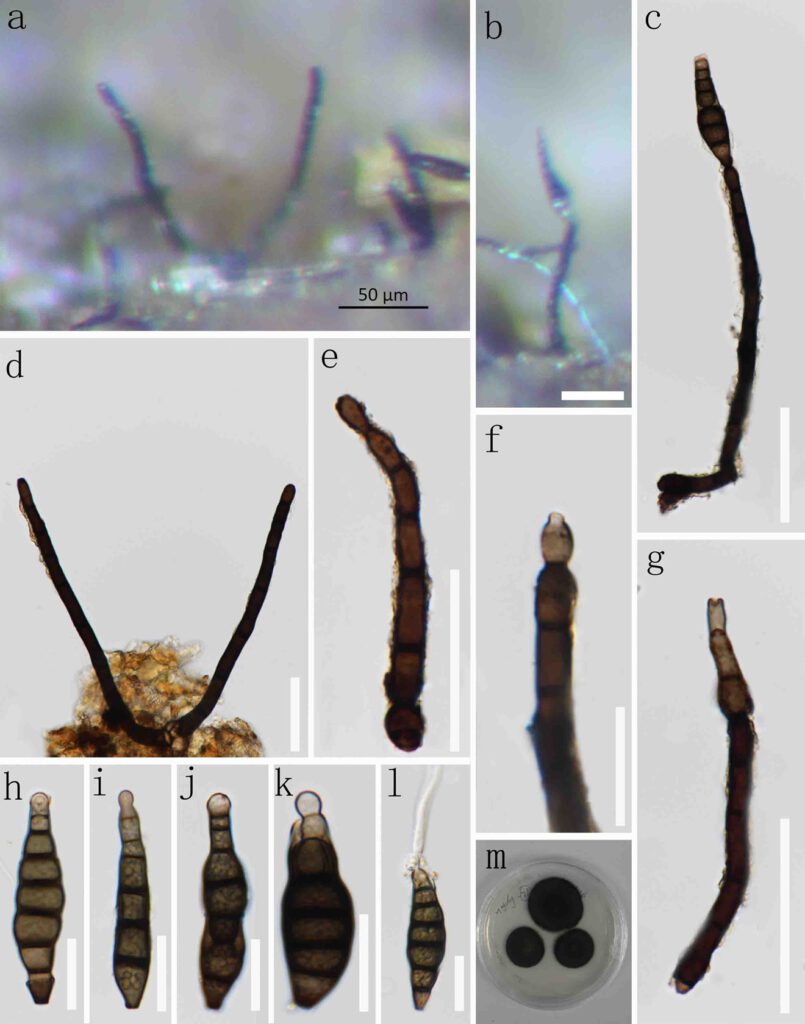Kirschsteiniothelia crustaceum S. Wang, Q. Zhao & K.D. Hyde sp. nov. Fig. 8
MycoBank number: MB; Index Fungorum number: IF; Facesoffungi number: FoF 11802;
Etymology:
Holotype: X
Saprobicon decaying bamboo culms. Sexual morph: Not observed. Asexual morph: Colonies effuse, scattered, dark brown to black, glistening, hairy, sparse. Mycelium partly superficial, partly immersed in the substratum, composed of dark brown, septate, branched hyphae. Conidiophores macronematous, mononematous, solitary, cylindrical, straight or slightly flexuous, brown to dark brown, slightly tapering towards the apex, 4–8 septate, truncate at the apex, 60–170 µm (x̄ = 128 µm, n = 15) long, 6.5–10.5 μm (x̄ =8 µm, n = 15) wide. Conidiogenous cells integrated, terminal, monoblastic, cylindrical and calyciform, brown, 9–16 µm (x̄ = 12 µm, n = 15) long, 5.5–8 μm (x̄ =6.5 µm, n = 15) wide. Conidia acrogenous, solitary, obclavate to obspathulate, globose to the apex and hyaline to light brown, rostrate, 5–6-euseptate, mid to dark brown, becoming pale brown to pale towards the apex, truncate at the base, 45–75 µm (x̄ = 55 µm, n = 20) long, 10–18 μm (x̄ = 14 µm, n = 20) wide.
Culture characteristics: Conidia germinating on MEA within 12h. at room temperature. Colonies on MEA, regular round shape, becoming filamentous in the culture, mycelium slightly raised, flattened, filiform, gray aerial hyphae, spreading from the center, becoming dark olivaceous-brown at the surface and olivaceous-brown to black in reverse, MEA change to light gray to light olivaceous-brown.
Material examined: Thailand, Nang Lae, Mueang Chiang Rai, Chiang Rai Province, saprobic on decaying bamboo, submerged in a freshwater stream, July 2020, Rongju Xu, MD71, (21-0129, holotype), extype culture, *****.
Notes: Kirschsteiniothelia crustaceum shares similar characters with K. rostrata in having macronematous, unbranched, cylindrical, septate, conidiophores and solitary, obclavate, septate, conidia. However, conidiophores of Kirschsteiniothelia crustaceum (60–170 × 6.5–10.5 μm) are much shorter than those of K. rostrata (up to 280 μm long, 12 μm wide). Coniia of K. crustaceum (45–75 × 10–18 μm) are much shorter than those of K. rostrata (up to 115 μm long, 15 μm wide) also. The combined LSU, SSU and ITS phylogenetic analysis shows that Kirschsteiniothelia crustaceum represents a sister taxon to K. rostrata with good separation.

Fig *** Kirschsteiniothelia crustaceum (MFLU ****, holotype) ab Colonies on dead wood. c Conidiophore with conidia. d–g Conidiogenous cells and conidia. h–k Conidia. l Germinating conidium. m Culture on MEA Scale bars: b –e = 50 μm, f = 20 μm, g = 50 μm, h –l = 20 μm.
